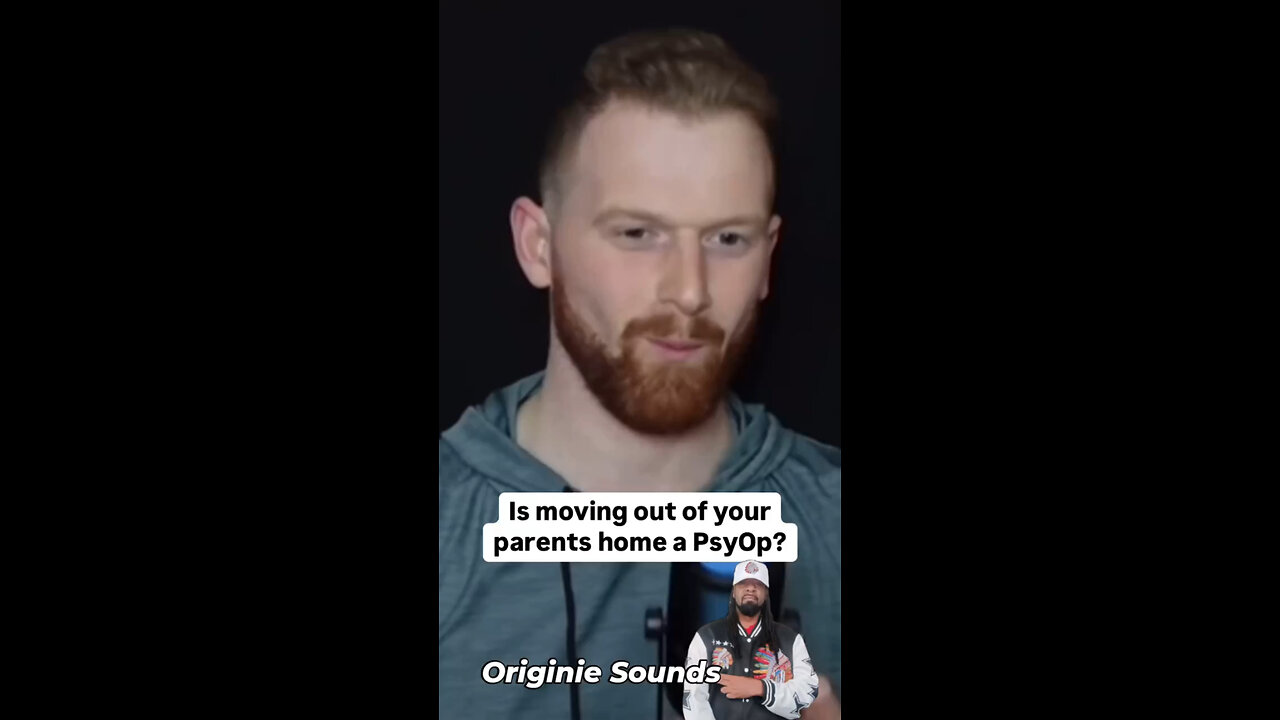Premium Only Content

The Psyop of Independence: Is Moving Out Truly Freedom or a Clever Trap?
Modern society champions independence as a hallmark of maturity. For decades, moving out of your family’s home has been seen as a rite of passage, a necessary step toward personal growth and adulthood. But beneath this ideal lies a question worth exploring: Is the push for individual living arrangements truly about freedom, or is it part of a larger system designed to fragment families, increase consumption, and erode communal bonds?
This article examines the deeper implications of the “move out” narrative, exploring how it impacts mental health, economics, and societal structures, and offers insights into how we might rethink the modern concept of independence.
1. The Economic Impact of Family Fragmentation
The Cost of Living Apart
When a family of ten lives under one roof, expenses are shared—one rent, one set of utilities, one set of groceries. However, when each member moves out, the financial burden multiplies:
• Housing Costs: In the U.S., rent or mortgage payments often consume a third or more of an individual’s income.
• Utilities: Electricity, water, internet, and other services are paid for individually, creating an exponential increase in consumption.
• Food Waste: Single-person households are notorious for wasting food due to the difficulty of buying and cooking for one.
The result? Families that could have pooled their resources to build generational wealth instead funnel their income into the pockets of landlords, utility companies, and grocery stores.
Consumerism as a Byproduct
Living alone often necessitates purchasing more: furniture, appliances, décor, and endless conveniences that wouldn’t be needed in a shared household. The fragmented family becomes a boon for consumer-driven economies, as individuals must sustain multiple households instead of one.
2. The Psychological Toll of Isolation
Loneliness: A Modern Epidemic
Humans are wired for connection. Families, historically, served as the primary unit of emotional support, shared responsibility, and communal living. But as families disperse, loneliness and depression have surged:
• A study by Cigna revealed that nearly 60% of Americans feel lonely, a number that continues to rise.
• Loneliness has been linked to a host of physical and mental health issues, including heart disease, weakened immune function, and cognitive decline.
The Illusion of “Connection”
Fragmented families often seek connection outside the home, turning to social media, dating apps, and entertainment. While these platforms promise connection, they often deepen feelings of isolation by replacing genuine relationships with superficial interactions.
3. The Historical and Cultural Context
The Decline of Multigenerational Living
For much of human history, multigenerational households were the norm. Families lived together, pooling resources, raising children collectively, and caring for elders. This model fostered:
• Economic Resilience: Shared expenses allowed families to invest in land, education, and businesses.
• Emotional Stability: Close-knit families provided a built-in support system during times of hardship.
However, the industrial revolution and urbanization disrupted this model. As jobs concentrated in cities, young people were encouraged to move away, leading to the nuclear family—and eventually, the “single-person household.”
Cultural Conditioning
Media and societal narratives have glorified the idea of moving out as the ultimate expression of independence. Films, TV shows, and advertisements often depict living with family as a sign of failure or immaturity, subtly encouraging young adults to seek autonomy at all costs.
4. The Systemic Drivers Behind the Psyop
Economic Incentives
Encouraging individuals to live separately benefits powerful industries:
• Real Estate: More renters mean higher demand for housing, driving up prices.
• Utilities: Separate households consume more electricity, water, and internet services.
• Entertainment: Isolated individuals are more likely to spend money on escapism, from streaming subscriptions to video games and vacations.
Social Control
A fragmented society is easier to control. When individuals are isolated, they lack the support networks that foster collective action and resistance:
• Eroded Solidarity: A dispersed family cannot easily unite to challenge injustices or pool resources for collective goals.
• Increased Dependency: Isolated individuals are more likely to rely on corporations and government programs for support, reducing their self-sufficiency.
5. Rethinking Independence: A Path Forward
Redefining Success
Instead of equating success with moving out, we can reframe independence as the ability to thrive within a community:
• Interdependence: True strength lies in mutual support. Families that live together can balance individual freedom with collective care.
• Shared Goals: Pooling resources allows families to invest in shared goals, such as homeownership, education, and entrepreneurship.
Reviving Multigenerational Living
Living together doesn’t mean sacrificing independence—it means creating a supportive environment where everyone can thrive:
• Elder Care: Aging parents receive care from their children, reducing the need for expensive nursing homes.
• Childcare: Younger generations benefit from the wisdom and support of grandparents, reducing childcare costs.
• Shared Wisdom: Living with family fosters the exchange of knowledge, traditions, and life skills.
Building Community Outside the Family
For those without close family ties, intentional communities or co-housing arrangements can offer similar benefits. These models emphasize shared resources, collective decision-making, and emotional connection.
6. Practical Steps to Reclaim Connection
1. Reevaluate Priorities
• Instead of chasing societal norms, ask: What truly makes me happy? What strengthens my sense of belonging and purpose?
2. Strengthen Family Bonds
• Regular communication, shared meals, and collaborative projects can rebuild connections even if family members live apart.
3. Create Shared Spaces
• If living together isn’t possible, create opportunities for connection, such as regular family gatherings or shared investments.
4. Challenge Cultural Narratives
• Recognize the societal conditioning that equates independence with isolation. Advocate for new narratives that value community and interdependence.
Conclusion: Freedom in Connection
The idea of moving out may promise freedom, but for many, it leads to isolation, financial strain, and disconnection. By questioning this narrative and embracing interdependence, we can build lives that are not only financially sustainable but also rich in connection, purpose, and joy.
True independence is not the absence of others—it’s the ability to thrive within a supportive network. Whether through family, chosen community, or intentional living arrangements, the path forward lies not in scattering but in coming together to create a future rooted in shared strength and collective well-being.
-
 39:25
39:25
FragmentsOfTruth
3 days agoThe Hidden Symbols of the New World Order: Decoding the $1 Bill & Global Control
258 -
 33:23
33:23
Adam Carolla
2 hours ago $3.99 earnedBorder Patrol Agent in Hot Water & Whoopi’s Dumbest Take Yet | The Adam Carolla | #news
3.29K5 -
 2:41:35
2:41:35
TimcastIRL
6 hours agoUSAID Orders Staff To SHRED & BURN ALL Documents, Deep State COVER UP w/Bubba Clem| Timcast IRL
173K70 -
 1:45:39
1:45:39
Kim Iversen
9 hours agoTrump Attacks Thomas Massie—But MAGA Isn’t Having It! Is Trump Picking the Wrong Fight?
53.9K110 -
 56:31
56:31
Glenn Greenwald
8 hours agoUNLOCKED EPISODE: On Europe’s Emergency Defense Summit, the Future of Independent Media, Speech Crackdowns and More
109K53 -
 43:48
43:48
BonginoReport
9 hours agoMainstream Media Plots The Next Plandemic! (Ep.02) - 03/11/2025
142K281 -
 1:13:13
1:13:13
Michael Franzese
9 hours agoMegyn Kelly’s UNFILTERED Take on The Ukraine War, Trump & Modern Masculinity
108K42 -
 1:43:21
1:43:21
Redacted News
10 hours agoBREAKING! UKRAINE AGREES TO CEASEFIRE WITH RUSSIA... BUT THERE'S A BIG CATCH | Redacted News
186K327 -
 58:17
58:17
Candace Show Podcast
11 hours agoShould We Feel Bad For Blake Lively? | Candace Ep 157
164K304 -
 3:06:52
3:06:52
The Nerd Realm
12 hours ago $12.28 earnedHollow Knight Voidheart Edition #19 | Nerd Realm Playthrough
98.3K5